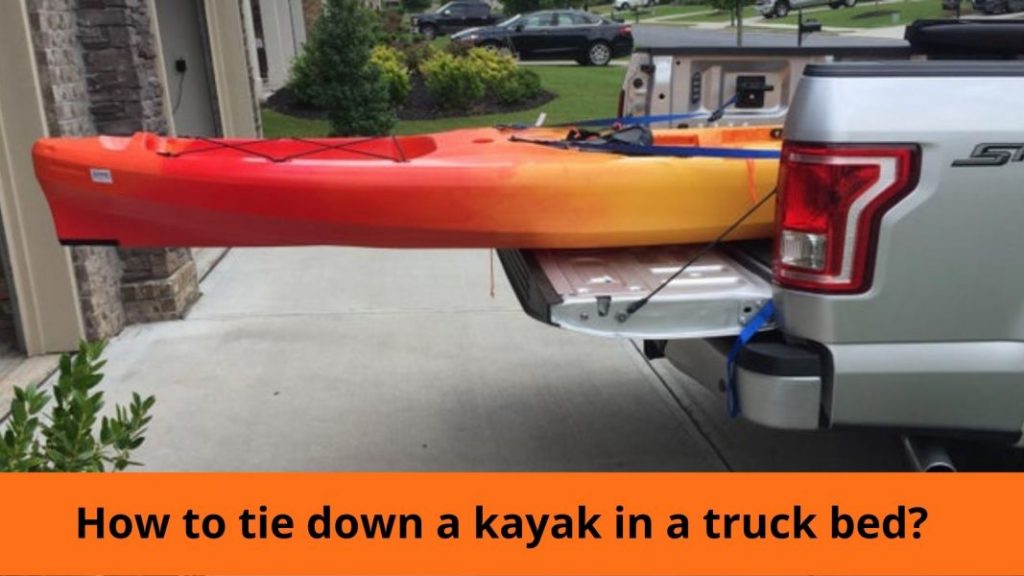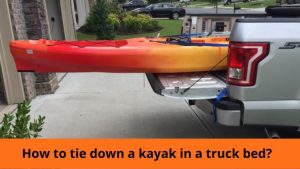Are you in search of How to tie down a kayak in a truck bed? Well, we’ve tried our best to cover this exciting topic in our article. It is very important to know the proper way to tie your kayak in a truck bed. So here are the best factors on our list that will help you out in many ways.

Proper way to tie your kayak
There are some important things that you should know before tying the kayak in your truck bed. There are several factors, including the size of your truck bed, the quantity, and the size of your kayak. We have also gathered a list of the most durable quality kayak roof rack.
1. Preparation of your truck bed:
The very first step to load or tie your kayak on your truck bed is to prepare your truck bed. Clear out your truck bed. Remove all the outrageous things that can act as a hurdle for your kayak. Whether you want to tie one kayak or two kayaks, it’s essential to remove all the extra things to make it as easy as possible to load your kayak in.
Removing all the things and hurdles from the truck bed will make it easy for you to load your kayak and reduce the chances of damaging your kayak (kayaks) in any way.
2. Install a good quality bed liner in your truck:
If there is no liner in your vehicle, we recommend installing one before tying your kayak (kayaks) in there. Establishing a good quality truck liner is also essential so that your kayak can be safe from getting any damage. A good liner will also protect your truck bed.
3. Place a small foam pad:
Place a small foam pad across the front of your truck bed. The soft padding will make your truck bed softer. You will have a softer surface for the bow of your kayak instead of placing it directly on the hard surface.
4. Use heavy-duty tie-down straps:
Set your kayak cam straps in place before you load your kayak into your truck bed. The kayak cam straps must be about 12 feet long so that you can secure your kayak firmly. Some truck beds have preinstalled hooks on the walls or surface of the bed. The hooks will help to give you tie-down points for your kayaks. The valid tie-down points you use will depend on the length of the cam straps and the size of the kayak that you are using.
5. Use tie-down points:
We will recommend you to use tie-down points of your truck bed instead of using higher tie-down points. It will increase the chances of securing your kayak in place and also strapping across your truck bed. This will also keep the door open for your kayak to slide right out of your truck bed if you are climbing a hill.
6. Place your kayak in the right direction:
After tying your kayak with the straps, the next step is to place your kayak in the truck bed. There are two ways to put your kayak. For both of the ways, it is suggested to place the hull of your kayak sitting against the bed of your truck.
7. Your kayaks can be load in two ways:
Some kayaks can be loaded straight into the truck bed so that they remain parallel with your truck. Some can be load at an angle which is also the best position to load your kayak. Loading a kayak at an angle is also best for shorter kayaks.
8. When to close the tailgate of your truck bed:
If your kayak sticks out of your truck bed than inside the truck, you will most likely want to leave the tailgate down and load your kayak straight in. this will eliminate the chance of getting your kayak into your kayak another lane if it is loaded in at an angle.
9. Never place the kayak head above the truck roof:
It is not safe to place your kayak in such a way that the front rests above the truck roof, and the stern is angle down into the back of the truck bed. In this position, the kayak will be impacted by the wind a lot, and there might be great chances of your strap losing its strength because of the wind pressure. As a result, the straps will get lost, and your kayak will fall out of the truck.
10. Secure your strap:
Now that you have successfully placed your kayak in your truck bed, the next step is to secure the straps in place. One thing to remember, if you have set your kayak using the angle method, then don’t forget to close the tailgate of your truck before you start securing kayak straps.
- The proper way to set your kayak strap:
The straps should always run over your kayak, thread through the cam closure. Then the strap should pull back towards your body to tighten. There should be no way to run the strap beneath your kayak because this will only lift your kayak as you tighten your straps. As a result, it will increase the chances of your kayak falling out of the truck.
- Run the straps through handles or D-rings:
Run the straps through the handles or D-rings that are attached to your kayak. These can work as anchor points for your kayak and help pull your kayak down and towards the front of your truck bed. Lastly, make sure the handles and D-rings of your kayak are permanently weld or mounted with your kayak with screws.
11. Use a bright color flag:
For the safety of you, your kayak, and other drivers, it is essential to attach a bright color flag. The best place to connect your flag is toggle handles at the stern.
The flags are attached to signal other drivers that your car/truck is longer than usual, and they should keep a safe distance. If you don’t have a bright color flag, use a bright color piece of cloth or handkerchief. The flag is used as a precautionary safety measure.
